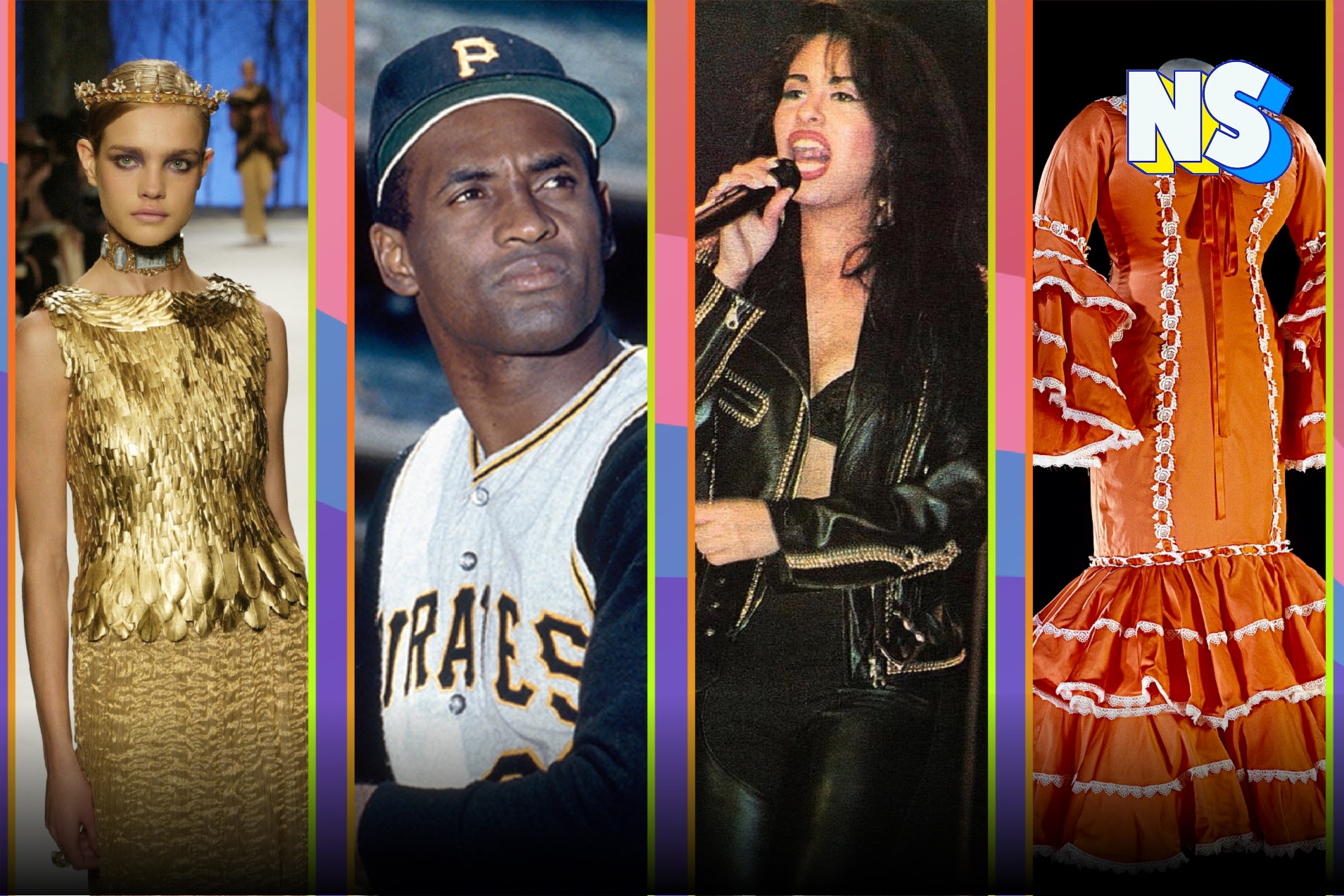Image courtesy of Nuestro Stories.
The influence of Latinos on American culture is undeniable; the Smithsonian knows this well and, through the years, has collected important items that make future generations of Latinos in the United States proud.
Here are ten cool items currently at the institution:
Selena’s leather outfit (1994)
Selena was the queen of Tejano Music and a fashion icon who wasn’t afraid to show both her Mexican and American heritage. Selena herself designed her iconic outfit that combined leather boots, tight pants, a satin bustier, and a motorcycle jacket. The outfit combined a style that characterizes her rebel and sexy aura. She wore this outfit for her live performance at the Tejano Music Awards in 1994, and it’s currently on view in the American Enterprise exhibition at the Smithsonian.
Oscar de la Renta Evening Dress (2002)
Renowned Dominican-American designer Oscar de la Renta created this evening dress for the House of Balmain in 2002. It’s a two-piece dress — a silk top covered with gilt cock feathers and a gold lame skirt. The dress was worn by Lee Radziwill, Jacqueline Kennedy’s sister, to the American Friends of Versailles event at the United Nations in September 2002.
Cesar Chavez’s union jacket (1960)
Cesar Chavez was a famous activist who founded the National Farm Workers Association in 1962, later becoming the United Farm Workers (UFW). Chavez designed the UFW logo, a black eagle with a white and red background, which can be seen on the left side of his jacket. His name is embroidered on the other side.
The “no grapes” pin represented the Delano Grape Strike of 1965 when Mexican and Pilipino farmworkers refused to pick grapes until their work conditions were upgraded. After Cesar Chavez died in 1993, his wife, Helen Chavez, donated his black nylon union jacket to the Smithsonian museum.
Frozen Margarita Machine (1971)
Inspired by the 7-Eleven Slurpee machine, Texas restaurateur and entrepreneur Mariano Martínez came up with the idea of the frozen Margarita machine. Martínez wanted to help bartenders serve drinks faster to customers, and the idea became popular among Mexican restaurants.
Although Mariano couldn’t patent the machine, his invention continued to attract people to his restaurant. After 34 years of work, the device ended up at the Smithsonian.
Celia Cruz’s Rumba Dress (1992)
Celia Cruz, also known as the “Queen of Salsa,” was the greatest exponent of the male-dominated music genre. Celia’s rumba dress or bata cubana adapts the garment commonly used in Cuba, and it’s an item she wore during her live performances. Her dress is made of orange polyester satin, trimmed with white nylon along the edges of the ruffles and a grommet along the seams with an orange ribbon insert. It’s been in the museum since 1997.
Roberto Clemente’s batting helmet and jersey (60’s and 70’s)
Roberto Clemente is a well-known name for sports fans. The Puerto Rican professional baseball player was famous for his personal and professional achievements, such as his 12 Gold Glove Award for reaching the 3,000-hit milestone. He died in 1978 in a plane crash while carrying supplies for earthquake victims in Nicaragua.
Roberto Clemente was widely admired for overcoming racism and language barriers. Clemente’s Pittsburgh Pirates batting helmet (1960) and his baseball jersey (1970) are currently in exhibition at the ¡Pleibol! In the Barrios and the Big Leagues/En los barrios y las grandes ligas..
New Mexican Inlaid cross (1859-1900)
It’s believed that this small wooden cross was made by either the Zuni or Navajo communities near Gallop, New Mexico. Native American decoration, with geometric shapes combined with elements of European Catholic devotional items, influenced a tradition that started generations ago. It’s kept alive by artists using the same technique today.
Scholars believe that straw applique originated in Spain and came to Mexico at the turn of the 19th century. Native Americans then adopted the technique, and it was spread throughout Mexico, reaching its northern regions where it became a popular artistic tradition.
This object is currently in the Many Voices, One Nation exhibition.
Blanca Rosa Vilchez’s suit from 9-11 (2011)
Peruvian-American Univision journalist Blanca Rosa Vilchez was near the World Trade Center on September 11, 2001. After witnessing the collapse of the Twin Towers, she ran for her life but stayed at the scene, reporting the news about the attacks for Univision. She had selected this blue jewel-toned blouse and black jacket specifically for that day because the weather forecast predicted a blue-sky day.
Beautyblender prototype (2005)
Rean Ann Silva, a Latina professional makeup artist, created in the ’00s the beauty blender, an egg-shaped sponge that revolutionized the beauty industry forever. The beauty blender prototype is currently in The Only One in The Room exhibition about women in male-dominated industries.
DACA butterfly wings (2018)
The Monarch butterflies take flight across the North American continent to survive each year. The Deferred Action for Childhood Arrivals (DACA), a policy memorandum that states that people who came to the U.S as children and met several requirements can obtain deferred action for two years, has readapted the symbol of the Monarch’s wings. The DACA butterfly wings were worn by a DREAMer from Nebraska on March 5, 2018. They are currently on view in the Girlhood (it’s complicated) exhibition.





